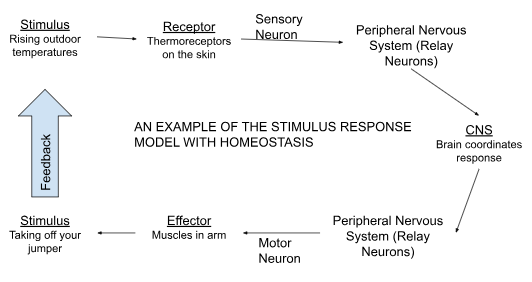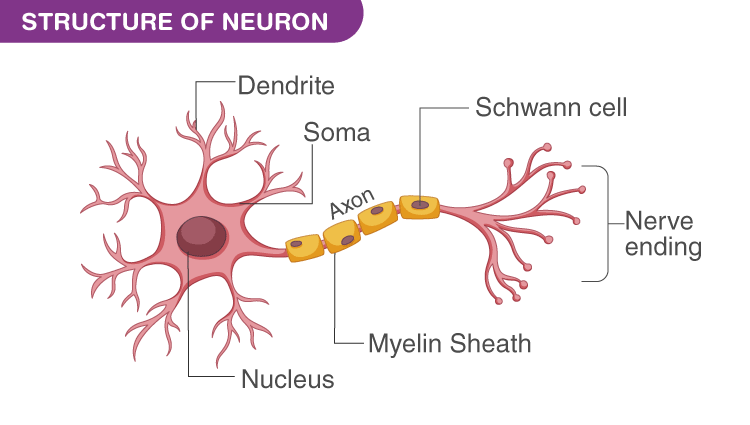Biology: Psychology/The Nervous System - Term 1
The nervous system:
It is a highly complex network of specialised cells (neurons) that controls how you sense, feel, think, and do. It responds to stimuli both inside and outside the body. It controls involuntary movements such as breathing and heart rate. Its main functions are to receive, process, and coordinate a response to information.
The nervous system is composed of:
Central Nervous System (CNS): It is composed of the brain and spinal cord. Its main role is to control the activities of other organs. It receives information from all parts of the body.
Peripheral Nervous System (PNS): It is composed of all other nerves in the body. Its job is to relay information to and from the CNS, and it can be divided into the autonomic (automatic responses) and somatic (voluntary responses) systems.
The Brain:
Also known as the control centre, it is an intricate network of cells that receives information from other parts of the body and responds to it. It is responsible for everything we do, feel and think.
The Spinal Cord:
The spinal cord is a long bundle of nerve tissue that extends from the base of the brain to the lower back. It receives sensory information from parts of the body (PNS) and sends it to the brain for processing. Once a response is decided by the brain, it sends the motor information that it receives from the brain to the designated parts of the body. Since the spinal cord is such a central part of the body’s communication, any damage that happens to it will lead to severe consequences depending on how high up the injury is. The higher it is, the more nerve connections are being severed.
Homeostasis:

Coordination:
It is a term that refers to the way all organs and systems work together to keep us alive. Cells of multicellular organisms cannot survive independently, so they depend on each other and work together. This requires organisation, coordination and control.
Homeostasis:
An environment that is comfortable and stable (pH levels, temperature, etc) for the cells is maintained through homeostasis. Homeostasis is a term used to describe a constant internal environment.
Your body systems need to work together so that a comfortable, stable environment (temperature, pH, concentration of ions, etc) for the cells is maintained. To stay alive, the body must be able to detect changes in the environment (both internal and external) and respond accordingly. Without homeostasis, you would die.
Neurons:
Neurons are individual nerve cells that make up the brain and nervous system. They all have three basic functions: receiving, processing, and communicating information to other cells.
There are three types of neurons:
Sensory/afferent neurons: Specialize in sending sensory information to the CNS
Relay/Interneuron: A communication link between the neurons
Motor/efferent neurons: Specialize in sending motor information from the CNS
Stimulus Response Model:
It consists of the stimulus (the internal or external change prompting action), the receptor (the cell that identifies the stimulus), the control centre or CNS (the part of the body that processes and coordinates the response to the stimulus), the effector (the muscles or parts of the body that respond to the stimulus) and the response. Between these stages, the different types of neurons and the PNS help relay information.
Receptors: Receptors are located in sensory organs (Mouth, Nose, Ear, Skin, Eyes)
Mechanoreceptors: sound waves, touch, pressure, pain
Chemoreceptors: smells and tastes (chemicals)
Photoreceptors: visible light
Thermoreceptors: Heat and temperature
Feedback:
Negative feedback: Most common and aims to reduce the stimulus.
Positive feedback: Uncommon and aims to increase the stimulus and therefore take away from homeostasis.

Reflex Arc:
Some actions need to be carried out very quickly (for survival). This means the message does not have to go to the brain. This type of pathway, which involves only a few neurons (3: sensory, interneuron, and motor neuron) and travels only to and from the spinal cord, is called a reflex arc. An example of this is the knee jerk reaction (patella ligament strike reaction) .
Structure of a neuron:
Dendrites: Branches at the start of the neuron. They receive and detect messages from other neurons. The signals can either be excitatory (make the neuron fire/generate an electrical impulse) or inhibitory (stop the neuron from firing). If the neuron fires, neural message (also known as an action potential) is conducted down the axon
Soma (Cell Body): Processes incoming signals. Appendages or protrusions that extend from the cell body are known as processes. Two types of processes are dendrites and the axon.
Nucleus: Located in the Soma, it contains information for making the proteins the neurons need
Axon: It is a longer process that extends from the cell body, which is specialized to transmit action potentials.
Myelin Sheath: Found on the axon, it is made up of fat and protein. The myelin sheath acts like insulation of electrical wires. It speeds up the transmission of a nerve impulse down the axon and protects the neuron from damage. Myelinated neurons are typically found in the peripheral nerves (sensory and motor neurons), while non-myelinated neurons are found in the brain and spinal cord.
Schwaan Cell: Cells that produce the myelin sheath
Node of Ranvier: Gaps in the myelin sheath
Axon Terminals: The end of the axon splits into axon terminals. Axon terminals make connections to other cells.

Synapse:
Neurons do not touch, so once information has reached the axon terminals, it must pass the gap to relay the information. The gap is called a synapse. When the nerve impulse reaches the axon terminals, tiny vesicles containing chemicals called neurotransmitters are transported to the cell membrane of the neuron. These chemicals are then released into the synapse. The neurotransmitters move across the synapse and bind to receptors on the membrane of the dendrites of the next neuron. This may result in triggering the receiving neuron to convert the message into a nerve impulse and conduct it along its length.
Neural Communication:
Neurons communicate from the dendrite to the axon terminals. They only go one way.
Learning and Memory:
Learning: Gaining new skills or knowledge
Memory: It is the processing, storage and retrieval of skills and knowledge acquired through learning. It is an internal record of prior experiences. Memory is not a single “thing” or process located in one specific area of the brain.
Atkinson-Shiffrin Model: